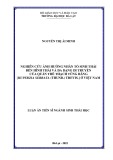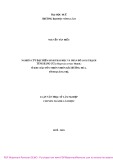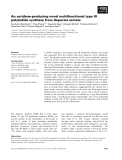
Journal of military pharmaco-medicine n
o
8-2019
115
TWO TRITERPENOIDS ISOLATED FROM ETHYL ACETATE
FRACTION OF Huperzia Serrata (Thunb.) Trevis
Le Dinh Manh
1
; Nguyen Van Thu
2
; Trinh Nam Trung
2
Nguyen Duy Bac
2
; Pham Duc Thinh
2
SUMMARY
Objectives: To extract, isolate, determine the structure of compounds from Huperzia serrata
(Thunb.) Trevis. Subjects and methods: The samples were collected in Tamdao National Park.
The structure of substances was determined by spectral methods. Results and conclusions: 2
compounds of terpenoid group were isolated, namely: 3β, 21β, 29-trihydroxyserrat-14-en-24-oic
acid-3β-yl- (7’-hydroxycinnamate); 16-oxo-3α-hydroxyserrat-14-en-21β-ol, the substances were
confirmed by the structure of NMR, MS, HMBC, HSQC.
* Keywords: Huperzia serrata (Thunb.) Trevis; Terpenoid; 3β, 21β, 29-trihydroxyserrat-14-
en-24-oic acid-3β-yl-(7’-hydroxycinnamate); 16-oxo-3α-hydroxyserrat-14-en-21β-ol.
INTRODUCTION
Huperzia serrata (Thunb.) Trevis belongs
to the family of Lycopodiaceae, which was
used as traditional medicinal plant in
treatment of types of lesions, hematemesis,
hematuria, hemorrhoids [1, 2]. In the 1980s,
scientists discovered an alkaloid compound,
huperzine A. The alkaloid compound has
been proven to be a potent, highly
specific, and reversible inhibitor of
acetylcholinesterase, and potential to
develop as a drug, which is used in
treatment of Alzheimer symptoms [3].
At Tamdao National Park (Vinhphuc
province), some plants belong to genus of
Huperzia were discovered, one of them is
identified as Huperzia serrata (Thunb.)
Trevis. Moreover, this genus is distributed
in wide area from north western midland
and mountainous, central, to central
highlands of Vietnam. This study was
conducted: To extract, isolate,
determine the structure of compounds
from Huperzia serrata (Thunb.) Trevis.
Results of our study provided more
information about phytochemical of
Huperzia serrata (Thunb.) Trevis.
MATERIALS AND METHODS
1. Materials.
The sample was collected at Tamdao
National Park (Vinhphuc province) and
was identified by Dr. Do Van Hai,
Department of Botany, Institute of
Ecology and Biological Resources,
Vietnam Academy of Science and
Technology. The sample was deposited
at the same Institute.
1. Military Medical College N
o
1
2. Vietnam Military Medical University
Corresponding author: Le Dinh Manh (manh.le40@gmail.com)
Date received: 08/09/2019
Date accepted: 10/10/2019





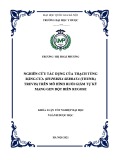
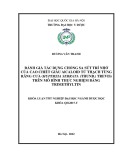
![Luận án Tiến sĩ Sinh thái học: Nghiên cứu ảnh hưởng nhân tố sinh thái đến hình thái và đa dạng di truyền của quần thể thạch tùng răng [Huperzia serrata (Thunb.) Trevis.] ở Việt Nam](https://cdn.tailieu.vn/images/document/thumbnail/2022/20221005/vilandrover/135x160/6061664965786.jpg)
